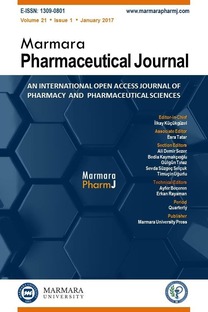Biological activity studies on the aqueous methanol extract of Anchusa undulataL. subsp. hybrida (Ten.) Coutinho
___
[1]Koz O, Pizza C, Kırmızıgül S. Triterpene and flavone glycosides from Anchusa undulatasubsp. hybrida.Nat Prod Res. 2009; 23(3): 284-292.[2]Kuruuzum-Uz A, Suleyman H, Cadirci E, Guvenalp Z, Demirezer LO. Investigation on anti-inflammatory and antiulcer activities of Anchusa azureaextracts and their major constituent rosmarinic acid. Z Naturforsch C. 2012; 67(7-8): 360-366.
[3]Kuruuzum-Uz A, Guvenalp Z, Kazaz C, Salih B, Demirezer LO. Four new triterpenes from Anchusa azureavar. azurea. Helv Chim Acta. 2010; 93(3): 457-465.
[4]Deveci E, Tel-Çayan G, Yıldırım H, Duru ME,. Chemical composition, antioxidant, anticholinesterase and anti-urease activities of Sideritis pisidicaBoiss. & Heldr. endemic to Turkey. Marmara Pharm J. 2017; 21(4): 898-905.
[5]Telagari M, Hullatti K. In-vitroα-amylase and α-glucosidase inhibitory activity of Adiantum caudatumLinn. and Celosia argenteaLinn. extracts and fractions. Ind J Pharmacol. 2015; 47(4): 425-429.
[6]Abirami A, Nagarani G, Siddhuraju P. In vitroantioxidant, anti-diabetic, cholinesterase and tyrosinase inhibitory potential of fresh juice from Citrus hystrixand C.maximafruits. Food Sci Hum Wellness. 2014; 3(1): 16-25.
[7]Kumarappan C, Mandal SC. α-Glucosidase inhibitory activity and in vitro antioxidant activities of alcohol-water extract (AWE) of Ichnocarpus frutescensleaves. Med Chem Res.2008; 17(2-7): 219-233.
[8]Ainsworth EA, Gillespie KM. Estimation of total phenolic content and other oxidation substrates in plant tissues using Folin-Ciocalteu reagent. Nat Protoc.2007; 2(4): 875-876.
[9]Yang H, Dong Y, Du H, Shi H, Peng Y, Li X. Antioxidant compounds from propolis collected in Anhui, China. Molecules. 2011; 16(4): 3444-3455.
[10]Wang H, Gao XD, Zhou GC, Cai L, Yao WB. In vitroand in vivoantioxidant activity of aqueous extract from Choerospondias axillarisfruit. Food Chem.2008; 106(3): 888-895.
[11]Re R, Pellegrini N, Proteggente A, Pannala A, Yang M, Rice-Evans C. Antioxidant activity applying an improved ABTS radical cation decolorization assay. Free RadicBiol Med. 1999; 26(9-10): 1231-1237.
[12]Ellman GL, Courtney KD, Andres V Jr, Feather-Stone RM. A new and rapid colorimetric determination of acetylcholinesterase activity. Biochem Pharmacol.1961; 7(2): 88-95.
[13]Ademiluyi AO, Oboh G. Soybean phenolic-rich extracts inhibit key-enzymes linked to type 2 diabetes (α-amylase andα-glucosidase) and hypertension (angiotensin I converting enzyme) in vitro. Exp Toxicol Pathol. 2013; 65(3): 305-309.
- ISSN: 1309-0801
- Yayın Aralığı: Yılda 6 Sayı
- Başlangıç: 1985
- Yayıncı: Marmara Üniversitesi
Simultaneous determination of selected flavonoids from different Cistusspecies by HPLC-PDA
PERİHAN GÜRBÜZ, Müberra KOŞAR, Zühal GÜVENALP, KURUÜZÜM Ayşe UZ, Lütfiye Ömür DEMİREZER
Bambang KUSWANDI, Prawita SARI, Mochammad Amrun HIDAYAT
Pınar TALAY PINAR, Yavuz YARDIM, Hoshyar Saadi ALİ, Abdullah Abdulwahed ABDULLAH, Zühre ŞENTÜRK
Analysis of anticancer drugs using thin layer chromatography–A review
Duygu UĞUR YENİCELİ, Alper UĞUR
Assessment of in vitrogenotoxicity effect of homosalate in cosmetics
Licorice cream promotes full-thickness wound healing in Guinea pigs
Nafise HANAFI, Fereshteh TALEBPOURAMIRI, Somayeh SHAHANI, Reza ENAYATIFARD, Maryam GHASEMI, Abbas Ali KARIMPOUR
Cebrail AKYÜZ, Orhan UZUN, Oguzhan SUNAMAK, Ayliz VELİOĞLU-ÖĞÜNÇ, Şule ÇETİNEL, Ahmet ÖZER ŞEHİRLİ
Kevser TABAN, Nuraniye ERUYGUR, Osman ÜSTÜN
Quantum-chemical free energy calculation of vinpocetine molecule release from sodium alginate
Yulia POLKOVNIKOVA, Halahakoon Amila JEEWANTHA, Kseniya KORYANOVA
Gökçen TELLİ, Banu Cahide TEL, Bülent GÜMÜŞEL, Kansu BÜYÜKAFSAR
